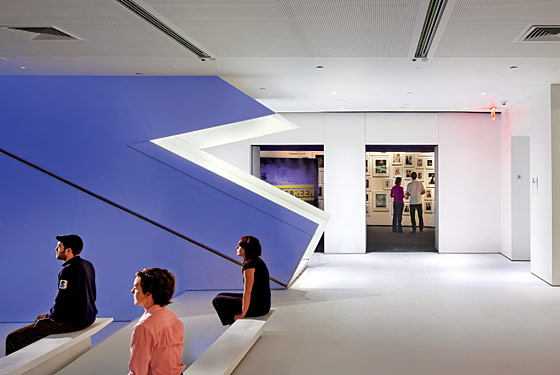
For an architect to build a museum of moving pictures is a bit like a vintner bottling mountain air. They’re everywhere, those squirmy apparitions. They cling to the side of a building, the back of an airplane seat, or the face of a wristwatch, yet remain essentially unchanged. How do you build a home for a rectangle of flickering light?
A movie theater sidesteps this metaphysical question by addressing parameters of comfort and consumption: the size of seats, the circumference of cup holders, the number of steps from ticket-taker to popcorn. But the Museum of the Moving Image in Astoria, which has just doubled in size with a new wing designed by Thomas Leeser, takes a multitudinous view of its subject. Video’s not just for watching, here. Visitors can play vintage arcade games, add sound effects to a movie clip, see ancient cameras, inspect mannequins, and immerse themselves in the fantastical, botanical, throbbing-pastel world of Chiho Aoshima’s City Glow, playing on a 50-foot screen in the lobby. Oh, and you can also see a movie.
Leeser first tried to meet the museum’s various obligations with architectural razzmatazz. In early designs, which I saw in 2005, he proposed coating the façade in moving images, and making visitors enter through an active screen. At the time, architects were besotted with video. Diller Scofidio + Renfro were planning the parade of freestanding screens that now march down 65th Street at Lincoln Center, enlivening a once bleak sidewalk with synchronized clips of performers at work. Even the conservative Robert A.M. Stern fitted out the lobby of the Comcast Center in Philadelphia with a wood-paneled wall that suddenly morphs into a giant sound-and-light show. Fortunately, the museum’s $67 million budget imposed restraint, and Leeser pared his design back to fundamentals.
The exterior is still a screen, but now the only show it offers is its own disappearance. Architects love to talk about their hunks of metal and concrete “dematerializing,” but this expanse of pale-blue metal sheets stretched taut over triangular frames really does nearly vanish into the sky. I visited on a winter day, when the panels’ steely sheen mingled with the morning light, leaving only a web of slender diagonals etched in the air. The triangles recall Buckminster Fuller’s rigid frames; Leeser, though, outlines the triangles not with rods but with gutters—strips of negative space.
Those thin voids continue inside. Walls float just above the floor. Channels run along the Corian banisters, perfect for rolling coins down. In the movie theater, a shell of blue fabric panels seems to float in front of a black wall, lighting emerges out of recesses in the ceiling, and a blue-lit moat encircles the seating area, so that the audience seems suspended in a weightless pod. These variously lit or shadowed cavities recall the frame around a television screen, a thin but impenetrable divider between the two- and three-dimensional worlds.
For a quarter century, the museum was crammed into the 1920 Kaufman Astoria Studio, where Gloria Swanson once sashayed in spangled silence. The historical displays still inhabit the slightly spiffed-up but otherwise intact original wing, to which Leeser has affixed his blue metal box. A long, white-on-white, glass-walled lobby fuses the old and new portions, and climbing the grand staircase to the windowless levels above is like springing off an airy cushion of light. It feels pleasantly upside-down, like rising into a cave.
Strong but minimal gestures highlight the seductiveness of movies. The new addition includes a 267-seat theater and a more intimate screening room. The hallway leading to each of those spaces is covered in luminescent fabric—Yves Klein blue for the theater, hot pink for the small room—so that heading toward a show is a little like being drawn into a bright abyss.
The essence of video is illusion, and Leeser’s design keeps visitors subtly, unconsciously off balance. Some interior walls tilt—not extravagantly, but just enough to disturb a sense of stability. A wall in the lobby looks perpendicular from one position, but as you come around the corner it begins to list. The grand staircase lifts off slightly cockeyed, which makes it appear to narrow toward the top.
The second-floor landing opens onto a raked video gallery, where bleachers line a snaking ramp. In most museums, video art is treated like a holy relic (or a profane objet), displayed in its own darkened sanctum. Here, it’s just part of the scene. Those who troop up the stairs can stop, sit and scrutinize, or just amble by. This is the border zone between the real and the virtual worlds. Packaged and natural light compete: the concentrated beam versus the pale radiance drifting from below.
From here, you can enter the old galleries, with its artifacts and memorabilia, or climb another flight to see the latest in video wizardry. One work in the opening exhibit, by the team Workspace Unlimited, places the viewer inside a 3-D simulation of Leeser’s design, effectively turning the museum into the setting for a highbrow video game. The elaborately imagined environments of gaming and the practice of actual architecture have been intertwining lately. Presentations of new designs often feature the “fly-through,” in which a camera scoots, wheels, and soars through a nonexistent space. Zaha Hadid translates the game experience into a finished design: her new contemporary-art museum in Rome, MAXXI, treats the visitor as an avatar, scooting across catwalks and staircases suspended in a vertiginous atrium. Leeser must have been tempted to play in that zone of overlap, dominated by drama, momentum, and strategic disorientation, but he avoids Hadid’s overbearing inventiveness, choosing a wiser kind of modesty. Instead of trying to imitate an already simulated world, he has tailored concrete and steel to the demands of mercurial images. He has bottled air.
